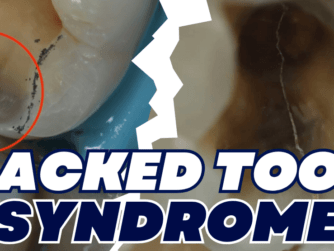Podcast: Play in new window | Download (Duration: 1:10:13 — 98.9MB)
Subscribe: RSS
Move over, traditional crowns! These ceramic onlays are way more conservative and just downright sexier. But let’s not go crazy – like with all aspects of Dentistry, case selection is key.
This episode is one for true Dental Geeks. Nik Sethi will adhesively blow your mind (wait….what did I just say?)
Imagine a 1 hour podcast episode after which you will improve your Onlays like never before – THIS is that episode. From the painful temporisation of onlays to the delicate bonding procedure, Nik leaves no stone unturned. Grab a pen and paper!
Protrusive Dental Pearl – use air abrasion on your Tanner/Michigan splints to help to see articulating paper marks more easily. Also it can be used to test compliance of your patients, as they will polish/grind away the abraded surface. Thank you Dr Tilly Houston for sending that one in!
In this episode we cover:
- When to place large composites vs opting for indirect ceramic restorations
- How to incorporate Immediate Dentine Sealing in to your workflow without feeling you have done anything different or additional
- How to become more efficient with your adhesive onlay preps
- When to start overlaying cusps, and when to leave them be (the answer may surprise you…)
- The full bonding protocol with heated composite (etch and all!)
- HOW TO TEMPORISE THE BLOODY THINGS
- When to shoulder….when to bevel?
Nik was really great – my only contribution to the show was the term ‘Vonlay’. You’re welcome, everyone!
If you loved Nik’s down-to-earth style of teaching, do check out their courses:
Elevate 6 – Elevate Dentistry (elevate-dent.com)
By very popular demand Riaz and Niks hands on 2 day course covering their FIPO protocol:
Leeds 12th & 13th March 2021
London 9th & 10th April 2021
London 23rd & 24th April 2021
Leeds 7th 8th May 2021
Leeds venue- Optident, Valley Drive, Ilkley, LS29 8AL
London venue- Blue room venue 220, Headstone Lane, HA2 6LY
2 Day – FIPO – Elevate Dentistry (elevate-dent.com)
Finally their pride and joy: Advanced Aesthetic Diploma.
Diploma – Elevate Dentistry (elevate-dent.com)
If you enjoyed this episode, you will love Emax Onlays and Vertipreps with Jason Smithson!








[…] might also enjoy Ceramic Onlays from Preps, Temporisation and Bonding Protocols by Nik […]
[…] If you enjoyed this episode, you will love delving deeper in to the full protocol in Ceramic Onlays from Preps, Temporisation and Bonding Protocols – PDP059 […]